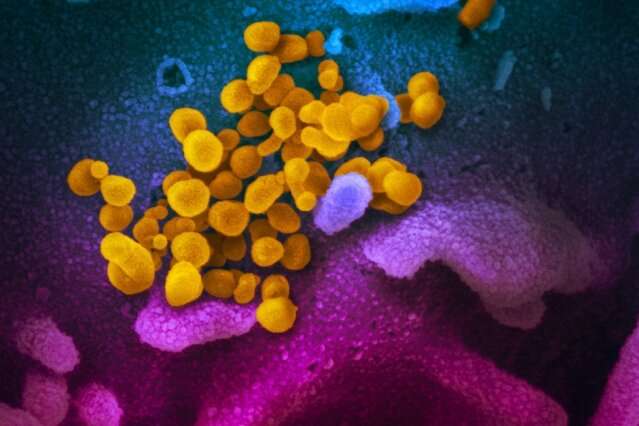This scanning electron microscope image shows SARS-CoV-2 (yellow)—also known as 2019-nCoV, the virus that causes COVID-19—isolated from a patient, emerging from the surface of cells (blue/pink) cultured in the lab. Credit: NIAID-RML
Microdroplets generated by speech can remain suspended in the air in an enclosed space for more than ten minutes, a study published Wednesday showed, underscoring their likely role in spreading COVID-19.
Researchers at the National Institute of Diabetes and Digestive and Kidney Diseases (NIDDK) had a person loudly repeat the phrase "Stay healthy" for 25 seconds inside a closed box.
A laser projected into the box illuminated droplets, allowing them to be seen and counted.
They stayed in the air for an average of 12 minutes, the study published in the journal Proceedings of the National Academy of Sciences (PNAS) showed.
Taking into account the known concentration of coronavirus in saliva, scientists estimated that each minute of loudly speaking can generate more than 1,000 virus-containing droplets capable of remaining airborne for eight minutes or more in a closed space.
"This direct visualization demonstrates how normal speech generates airborne droplets that can remain suspended for tens of minutes or longer and are eminently capable of transmitting disease in confined spaces," the researchers conclude.
The same team had observed that speaking less loudly generates fewer droplets, in a work published in the New England Journal of Medicine in April.
If the level of infectiousness of COVID-19 through speech can be confirmed, it could give a scientific boost to recommendations in many countries to wear a face mask, and help explain the virus's rapid spread.
More information: Valentyn Stadnytskyi et al. The airborne lifetime of small speech droplets and their potential importance in SARS-CoV-2 transmission, Proceedings of the National Academy of Sciences (2020). DOI: 10.1073/pnas.2006874117
Journal information: Proceedings of the National Academy of Sciences , New England Journal of Medicine
© 2020 AFP
























